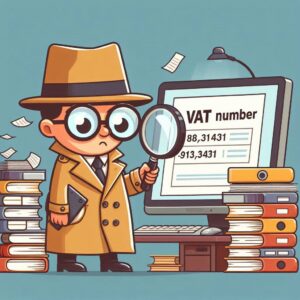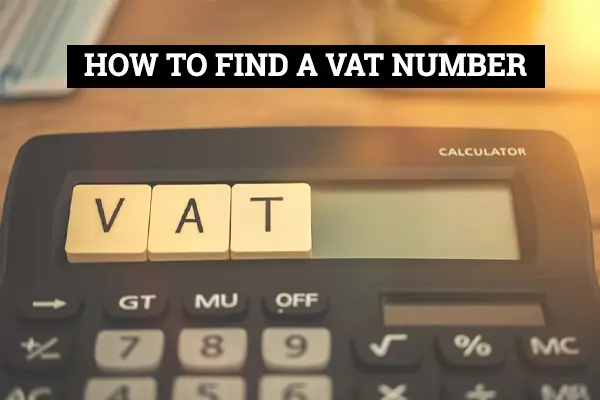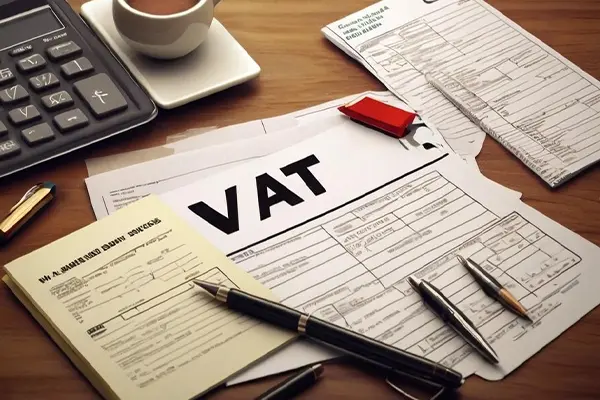How to Find A Company’s VAT Number?
Finding a company’s VAT number can be essential for business operations, especially for VAT-related transactions. Value-added Tax verifies a company’s VAT status, impacting financial transactions, invoicing, and tax reporting. This guide explains how to find a VAT number for a company in the UK, understand its format, and why it’s crucial in UK business.
What is a Company’s VAT Number?
A VAT number is a unique identifier assigned to businesses registered for Value Added Tax (VAT). In the UK, this number allows companies to charge VAT on goods and services and report this tax to HMRC. VAT is crucial for ensuring compliance with tax regulations and should be displayed on invoices, receipts, and other financial documents. Knowing a company’s VAT is essential for business transactions, especially when it comes to reclaiming VAT on purchases.
What is a VAT Number and Why is it Important?
A VAT number is critical for any VAT-registered business in the UK. It allows companies to legally collect and pay VAT on sales, ensuring compliance with HM Revenue and Customs (HMRC) requirements. A Value Added Tax is used on invoices, in tax returns, and for other financial records. If a company’s VAT no is valid, it assures that they’re registered to charge VAT and remit it to HMRC.
Legality: A Value Added Tax confirms that a business is officially registered to collect VAT. It assures customers and suppliers that the business complies with tax regulations.
Tax Reporting: Businesses must report their VAT transactions to HMRC regularly. The VAT registration code is required for submitting VAT returns, which detail how much VAT has been charged and paid.
Invoicing: When issuing invoices, including the Company VAT number is necessary for VAT-registered businesses. It informs customers about the VAT charged and allows them to reclaim VAT on their purchases if they are also VAT-registered.
International Trade: For companies engaging in cross-border transactions within the European Union (EU) and beyond, a Value Added Tax number is essential. It allows businesses to operate seamlessly in different markets, adhering to tax regulations.
Reclaiming VAT: VAT-registered businesses can reclaim the VAT they pay on goods and services purchased for their business. Having a VAT is a prerequisite for making these claims, thus improving cash flow and reducing overall tax liabilities.
Standard Format of a UK VAT Number
In the UK, a VAT number follows a specific format: it consists of nine digits, usually starting with “GB.” For example, a VAT number might look like “GB123456789.” Knowing the correct format can help avoid issues when verifying VAT.
| Country | VAT Prefix | Number of Digits | Example |
|---|---|---|---|
| UK | GB | 9 Digits | GB1234567 |
VAT Number Applied For?
When a business applies for a VAT number, it undergoes a registration process with HMRC. This application is typically necessary once a company’s taxable turnover exceeds the VAT registration threshold, which is currently £85,000. Upon approval, HMRC issues a unique VAT no to the company, which must be used on invoices, tax returns, and other financial documents. It’s essential to ensure that all communications and transactions include this VAT compliance number once it has been granted.
Find VAT Number for a Company
To find the VAT number for a company, you can utilize several approaches. Start by checking the company’s website or its official communications, where VAT no are often listed. If you cannot find the VAT certificate number there, you can use the HMRC online VAT code checker to verify it once you have it. Public records from Companies House may also provide useful information regarding VAT registration. In cases where you still need assistance, directly contacting the company can provide the most accurate and up-to-date information.
How to Find Any Company’s VAT Number
When you need to find a company’s VAT no, there are several methods:
- Search Public Records: UK public records, like Companies House, may list VAT information for registered companies.
- Check the Company’s Website or Invoices: Many companies display their Value Added Tax number on invoices or websites, particularly in the “About” or “Legal” sections.
- Use an Online VAT No-Finder: Various online databases and HMRC resources provide VAT lookup tools.
- Contact the Company Directly: If other methods don’t work, reaching out to the company is a practical option.
These methods make it straightforward to find a company’s VAT compliance number, especially for transactions requiring VAT verification.
How to Check a UK VAT Number?

Verifying a UK VAT number is crucial to ensure it’s legitimate and active. Here are two main methods to check it.
1. Use the HMRC Online VAT Number Checker
HMRC provides an online tool where you can enter a VAT number and check its validity. This free service verifies whether a VAT number belongs to a registered company in the UK.
2. Call the HMRC VAT Helpline
If you need further assistance or prefer speaking with an HMRC representative, you can call the VAT helpline. The HMRC helpline can confirm the legitimacy of the VAT number and provide additional guidance if required.
How Do I Find a Company’s VAT Number?
Finding a VAT number involves using resources like HMRC’s VAT checker, company records, or directly contacting the business. Here’s a structured approach to help you find any UK company’s VAT registration number.
4 Ways to Find Your Company’s VAT Number
If you need to find your own company’s VAT number, here are four common places to check:
1. Check Your VAT Registration Certificate
When a business registers for VAT, HMRC issues a VAT registration certificate. This document includes your VAT number and serves as proof of registration. Keeping it accessible is helpful for accounting and compliance purposes.
2. Check Your VAT Returns
VAT numbers also appear on VAT return documents. Reviewing past returns can help you quickly locate the number if it’s needed for filing or verification.
3. Contact HMRC
If you can’t find your VAT certificate or returns, contacting HMRC is another option. The agency can provide VAT registration details to registered company representatives after confirming identification.
4. Check Your Accounting Software
Many accounting software programs store VAT registration information, including your VAT reference number. Software systems like QuickBooks, or Sage often include VAT details within company profiles or tax settings, making it easy to locate.
| Method | Column 2 |
|---|---|
| VAT Registration Certificate | Issued by HMRC upon registration |
| VAT Returns | Appears on submitted VAT returns |
| HMRC | By contacting their VAT helpline |
| Accounting Software | Company profile or tax settings |
VAT Number Changed Should I Change PAYE?
If your VAT number changes, it’s crucial to consider how this affects your PAYE (Pay As You Earn) tax obligations. Generally, a change in VAT number should not directly impact your PAYE, as these are separate tax systems. However, if the change is due to a change in business structure or registration status, it may affect how you manage your PAYE reporting. It’s advisable to inform HMRC of any changes to your VAT registration to ensure that all tax records are up to date, avoiding potential confusion in tax filings.
Additional Tips for VAT Verification and Compliance
For additional verification, there are online tools and software that can validate VAT numbers. Additionally, maintaining accurate records of all VAT-related documents ensures you always have access to the information you need.
Conclusion
Knowing how to find a company’s VAT number is invaluable for UK businesses, helping maintain smooth financial transactions and VAT compliance. Whether you’re looking to confirm a Company VAT number, verify legitimacy, or find your own company’s VAT registration, following the outlined steps simplifies the process. Accurate VAT verification protects businesses from potential errors or tax issues, ensuring they stay compliant with HMRC requirements.
FAQs:
- How Do I Check a UK VAT Number?
To check a UK VAT number, visit the HMRC website and use their online VAT number checker. Simply enter the VAT number in question, and the tool will confirm if it’s valid and registered to a legitimate business, helping you ensure compliance in your transactions. - Can I Check a UK VAT Number Online?
Yes, you can check a UK VAT number online through the HMRC VAT number checker. This service is free and allows you to verify whether a VAT number is active and associated with a registered business, providing peace of mind in your dealings. - How to Find a UK Company VAT Registration Number?
To find a UK company’s VAT registration number, start by checking their invoices or official communications, where it is usually listed. Alternatively, you can search for the company on Companies House, where registration details, including VAT numbers, may be available. - How to Find My VAT Number?
You can find your VAT number on the VAT registration certificate issued by HMRC. If that document is unavailable, check previous VAT returns, as your VAT number should be listed there. If you still can’t locate it, contacting HMRC directly will help you retrieve it. - How to Find a Company VAT Number?
To find a company VAT number, check their website or any recent invoices, as VAT account numbers are often displayed there. If you cannot find it, use the HMRC online VAT number checker with any existing number you have to verify it or contact the company directly for assistance.
















